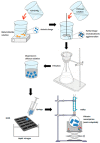Immobilization of Metal Hexacyanoferrate Ion-Exchangers for the Synthesis of Metal Ion Sorbents--A Mini-Review
- PMID: 26610439
- PMCID: PMC6332395
- DOI: 10.3390/molecules201119718
Immobilization of Metal Hexacyanoferrate Ion-Exchangers for the Synthesis of Metal Ion Sorbents--A Mini-Review
Abstract
Metal hexacyanoferrates are very efficient sorbents for the recovery of alkali and base metal ions (including radionuclides such as Cs). Generally produced by the direct reaction of metal salts with potassium hexacyanoferrate (the precursors), they are characterized by ion-exchange and structural properties that make then particularly selective for Cs(I), Rb(I) and Tl(I) recovery (based on their hydrated ionic radius consistent with the size of the ion-exchanger cage), though they can bind also base metals. The major drawback of these materials is associated to their nanometer or micrometer size that makes them difficult to recover in large-size continuous systems. For this reason many techniques have been designed for immobilizing these ion-exchangers in suitable matrices that can be organic (mainly polymers and biopolymers) or inorganic (mineral supports), carbon-based matrices. This immobilization may proceed by in situ synthesis or by entrapment/encapsulation. This mini-review reports some examples of hybrid materials synthesized for the immobilization of metal hexacyanoferrate, the different conditionings of these composite materials and, briefly, the parameters to take into account for their optimal design and facilitated use.
Keywords: biopolymers; composite materials; encapsulation; in situ synthesis; ion-exchanger; metal hexacyanoferrate; polymers; porous mineral supports.
Conflict of interest statement
The authors declare no conflict of interest.
Figures







Similar articles
-
Preparations of PAN-based adsorbers for separation of cesium and cobalt from radioactive wastes.Appl Radiat Isot. 2007 May;65(5):482-7. doi: 10.1016/j.apradiso.2006.12.003. Epub 2006 Dec 28. Appl Radiat Isot. 2007. PMID: 17270450
-
Selective transport of ions and molecules across layer-by-layer assembled membranes of polyelectrolytes, p-sulfonato-calix[n]arenes and Prussian Blue-type complex salts.Adv Colloid Interface Sci. 2005 Nov 30;116(1-3):121-31. doi: 10.1016/j.cis.2005.05.003. Epub 2005 Aug 8. Adv Colloid Interface Sci. 2005. PMID: 16091277 Review.
-
Colloid stable sorbents for cesium removal: preparation and application of latex particles functionalized with transition metals ferrocyanides.J Hazard Mater. 2011 Feb 28;186(2-3):1343-50. doi: 10.1016/j.jhazmat.2010.12.009. Epub 2010 Dec 10. J Hazard Mater. 2011. PMID: 21208744
-
Theorization on ion-exchange equilibria: activity of species in 2-D phases.J Colloid Interface Sci. 2004 Nov 1;279(1):1-22. doi: 10.1016/j.jcis.2004.07.010. J Colloid Interface Sci. 2004. PMID: 15380407
-
Beneficial role of surfactants in electrochemistry and in the modification of electrodes.Adv Colloid Interface Sci. 2006 Jan 31;119(1):55-68. doi: 10.1016/j.cis.2005.09.004. Epub 2005 Dec 2. Adv Colloid Interface Sci. 2006. PMID: 16325752 Review.
Cited by
-
Amino-functionalized magnetic chitosan beads to enhance immobilization of potassium copper hexacyanoferrate for selective Cs+ removal and facile recovery.RSC Adv. 2019 Jan 9;9(2):1106-1114. doi: 10.1039/c8ra09386e. eCollection 2019 Jan 2. RSC Adv. 2019. PMID: 35517610 Free PMC article.
-
Radionuclides' Recovery from Seawater Using FIC and FIC A Sorbents.Materials (Basel). 2023 Jun 4;16(11):4181. doi: 10.3390/ma16114181. Materials (Basel). 2023. PMID: 37297315 Free PMC article.
-
Composite Zn(II) Ferrocyanide/Polyethylenimine Cryogels for Point-of-Use Selective Removal of Cs-137 Radionuclides.Molecules. 2021 Jul 29;26(15):4604. doi: 10.3390/molecules26154604. Molecules. 2021. PMID: 34361764 Free PMC article.
-
Iron-Vanadium Incorporated Ferrocyanides as Potential Cathode Materials for Application in Sodium-Ion Batteries.Micromachines (Basel). 2023 Feb 23;14(3):521. doi: 10.3390/mi14030521. Micromachines (Basel). 2023. PMID: 36984928 Free PMC article.
-
Polyethylenimine as a Non-Innocent Ligand for Hexacyanoferrates Immobilization.Molecules. 2022 Dec 2;27(23):8489. doi: 10.3390/molecules27238489. Molecules. 2022. PMID: 36500581 Free PMC article.
References
-
- Gaur S. Determination of Cs-137 in environmental water by ion-exchange chromatography. J. Chromatogr. A. 1996;733:57–71. doi: 10.1016/0021-9673(95)00906-X. - DOI
-
- Heyltex Radiogardase. [(accessed on 10 August 2015)]. Available online: http://www.heyltex.com/products/radiogardase.
Publication types
MeSH terms
Substances
LinkOut - more resources
Full Text Sources
Other Literature Sources

